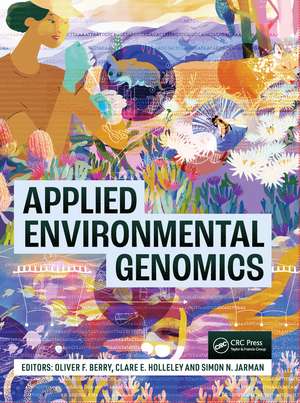Applied Environmental Genomics
Editat de Oliver F. Berry, Clare E. Holleley, Simon N. Jarmanen Limba Engleză Hardback – 19 ian 2024
Applied Environmental Genomics synthesises the latest and most exciting uses of genomic technologies for environmental science and management. With an emphasis on diversity of applications and real-world demonstrations, leading researchers have contributed detailed chapters on innovative approaches to obtaining critical management-relevant information about the natural world. These chapters are complemented by perspective sections written by environmental managers who describe their experiences using genomics to support evidence-based decisions.
Ideal for students, researchers and professionals working in natural resource management and policy, Applied Environmental Genomics is a comprehensive introduction to a fast-moving field that is transforming the practice of environmental management, with profound relevance to industry, government and the public.
Preț: 875.84 lei
Preț vechi: 962.46 lei
-9% Nou
Puncte Express: 1314
Preț estimativ în valută:
167.58€ • 175.91$ • 139.10£
167.58€ • 175.91$ • 139.10£
Carte disponibilă
Livrare economică 20 martie-03 aprilie
Livrare express 05-11 martie pentru 65.13 lei
Preluare comenzi: 021 569.72.76
Specificații
ISBN-13: 9781032584508
ISBN-10: 1032584505
Pagini: 368
Ilustrații: 76 Illustrations, color; 4 Illustrations, black and white
Dimensiuni: 210 x 270 x 26 mm
Greutate: 1.44 kg
Ediția:1
Editura: CSIRO Publishing
Colecția CRC Press
ISBN-10: 1032584505
Pagini: 368
Ilustrații: 76 Illustrations, color; 4 Illustrations, black and white
Dimensiuni: 210 x 270 x 26 mm
Greutate: 1.44 kg
Ediția:1
Editura: CSIRO Publishing
Colecția CRC Press
Public țintă
Postgraduate, Professional Practice & Development, Professional Reference, and Undergraduate AdvancedCuprins
Section A: Biodiversity 1. Design considerations for eDNA metabarcoding surveys 2. Measuring biodiversity with eDNA metabarcoding 3. Perspective – eDNA and metagenomics: a story of a disruptive technology for biodiversity monitoring 4. Revealing animal diet and food webs through DNA metabarcoding 5. Approaching ecological questions using DNA barcodes Section B: Life history and population biology 6. Lifespan estimation from genomic analysis 7. Development of epigenetic clocks 8. Molecular sex identification for applications in conservation, industry and veterinary medicine 9. Perspective – Whole genome assemblies, devils and disease 10. Genetic-based inventories of wildlife abundance 11. The practical magic of close-kin mark-recapture 12. Perspective – Genomics and bear management 13. How can we use genomics to predict and improve population viability? Section C: Adaptation and change 14. Adaptive responses to the environment and environmental change 15. Perspective – The power of genomics for guiding reintroductions 16. Palaeo- and museo-genomics: perspectives on modern species 17. Perspective – Genomics and the prioritisation of taxa and populations for conservation Section D: Environmental molecular physiology 18. Applied epigenomics in a rapidly changing world 19. DNA-based microbial bioindication of environmental state 20. Perspective – The promise of ecotoxicogenomics for assessing aquatic health Section E: Spatial genomics 21. Unravelling plant-pollinator interactions through pollen DNA analysis 22. Genomic approaches to study dispersal in wild animal populations: implications for wildlife management 23. Conservation prioritisation based on evolutionary distinctiveness of communities Section F: Biosecurity and disease monitoring 24. Invasive species detection and management using genomic methods 25. Genomic identification and surveillance of infectious diseases in natural systems 26. Management of vertebrate pests using genetic control techniques 27. Perspective – The ‘E’ in RD&E and the application of genomics for environmental and biosecurity risk management
Notă biografică
Oliver F. Berry is Director of the Environomics Future Science Platform at CSIRO. His career has featured a diversity of genomics techniques from population genomics to environmental DNA, and he has worked in application domains from conservation biology to invasive species management.
Clare E. Holleley is a Principal Research Scientist at National Research Collections Australia (CSIRO). She is an expert in vertebrate sex determination and an innovator in the field of historical epigenomics. Her work characterises rates of evolutionary change in ecological, reproductive and disease research.
Simon N. Jarman is Professor of Environmental Genomics at Curtin University. He is an expert in analysis of animal age and life cycles with genomic methods, and environmental DNA analyses of species diversity.
Clare E. Holleley is a Principal Research Scientist at National Research Collections Australia (CSIRO). She is an expert in vertebrate sex determination and an innovator in the field of historical epigenomics. Her work characterises rates of evolutionary change in ecological, reproductive and disease research.
Simon N. Jarman is Professor of Environmental Genomics at Curtin University. He is an expert in analysis of animal age and life cycles with genomic methods, and environmental DNA analyses of species diversity.
Descriere
This book synthesises uses of genomic technologies for environmental science and management. With an emphasis on diversity of applications and real-world demonstrations, leading researchers have contributed chapters on innovative approaches to obtaining critical management-relevant information about the natural world.
